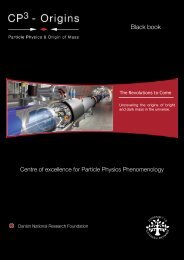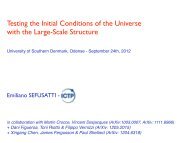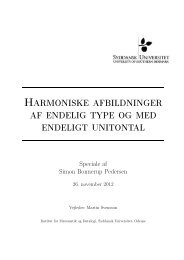PhD thesis - CP3-Origins
PhD thesis - CP3-Origins
PhD thesis - CP3-Origins
Create successful ePaper yourself
Turn your PDF publications into a flip-book with our unique Google optimized e-Paper software.
QCD and Chiral Symmetry Breaking 23According to the Goldstone theorem N f − 1 massless Goldstone bosons should appear.Next, we will discuss how to write down an effective theory describing the Goldstonebosons.3.1. Effective LagrangianIf a theory with a global symmetry G posseses a vacuum state which respects only asubgroup H of G, the action of G on this state generates a manifold of degenerate vacua.Any given state in this manifold is unchanged by a group of transformations isomorphic toH. Hence the set of transformations of degenerate vacua is isomorphic to the coset spaceG/H. Transformations in G/H correspond to directions of variations of the Lagrangianin which the effective action is level at its minimum. Quantizing the excitations alongthese direction produces zero mass particles one for each orthogonal direction in G/H.Next we will figure out how the Goldstone bosons fields transform following reference[21].The Goldstone theorem states that after the breaking there are dim(G)−dim(H)Goldstone bosons. The group G acts on the Goldstone bosons through some representationπ g → φ(g, π), g ∈ G. (3.12)Because φ is a representation, we have the composition lawφ(g 1 , φ(g 2 , π)) = φ(g 1 g 2 , π). (3.13)Let us consider the image of the origin, φ(g, 0). The set of elements h which map theorigin onto itself forms a subgroup H ∈ G. Furthermore φ(gh, 0) = φ(g, 0) according tothe composition law for any g ∈ G, h ∈ H. The function φ(g, 0) thus maps G/H on thespace of Goldstone bosons fields. As the dimension of the coset space is equal to thenumber of the Goldstone bosons, these can be identified with the coordinates of G/H.Thus the Goldstone bosons are said to live on the coset space.Every element of G can be uniquely decomposed as g = ξh where ξ is an element ofone of the equivalent classes {gh, h ∈ H}. Using the composition propertyφ(h, ξ ′ ) = φ(h, φ(g ′ , ξ)) = φ(hg ′ , ξ) (3.14)








